Encrypt Email (S/MIME + RSA-OAEP) in Exchange Server and IIS SMTP Service
Email Encryption protects email content from exposure to inappropriate recipients. Encrypting email doesn’t require the
sender certificate but the certificate and the public key of the recipient.
For example:
-
sender@emailarchitect.net sends an email to
rcpt@emailarchitect.net with digital signature,
- The digital signature contains the public key certificate for
sender@emailarchitect.net,
- Then
rcpt@emailarchitect.net can send an email encrypted by public key of this certificate back to
sender@emailarchitect.net.
- Only
sender@emailarchitect.net can read this email, because this email can ONLY be decrypted by private key of
sender@emailarchitect.net.
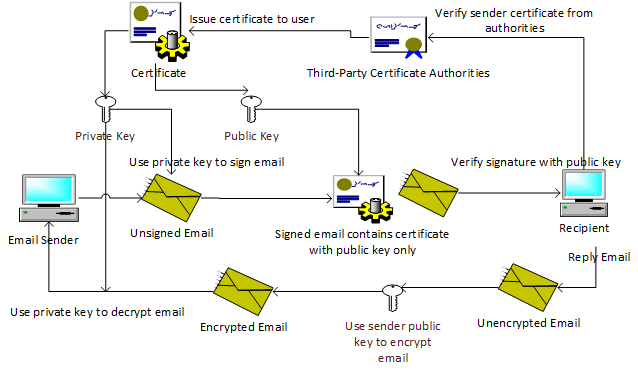
Therefore, you must receive a digital signed email from other people (
Most email clients such as outlook, outlook express will add the certificate to the Other People Storage automatically
once an digital signed email is received) before you can return an encrypted email to this people.
To encrypt email with EA S/MIME in your IIS SMTP Service or Exchange Server, you need to export the recipient’s certificate
first.
Encrypting Email (S/MIME) in Email Client
Most popular email clients support email encryption. To enable email encryption in your email client, you need the certificate
of the email recipient. You can refer to the documentation of your email client for the settings.
This tutorial introduces how to use S/MIME Plugin to encrypt email in IIS SMTP Service or Exchange 2003 automatically without
an email client. If you send emails from an email tool that doesn’t support email encryption, this plugin can help to
encrypt email on server side.
How S/MIME Plugin Works?
In IIS SMTP Service or Exchange 2003, S/MIME Plugin works as a SMTP event sink; in Exchange 2007/2010/2013/2016, it works
as a transport agent. It encrypts an email with a digital certificate based on pre-defined rules.
An encryption rule can be defined for a single recipient or multiple recipients.
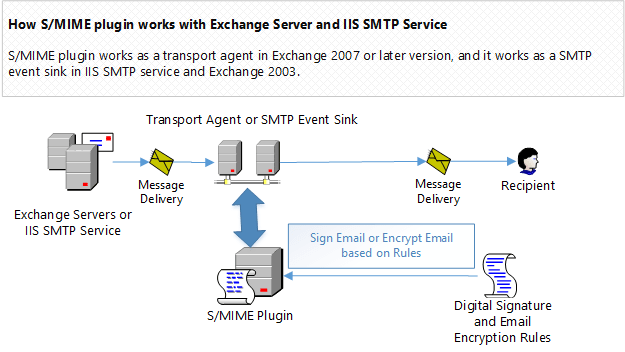
Import, Export and Generate Test Certificate
To view/import/export certificate in
Current User Store and
Local Machine Store, you can open the
Certificates MMC Snap-in like this:
- On the
Windows Start menu, click
Run, and then type
mmc. Click Enter. This starts the
Microsoft Management Console (MMC).
- In the console, click the
File menu and then click
Add/Remove Snap-in.
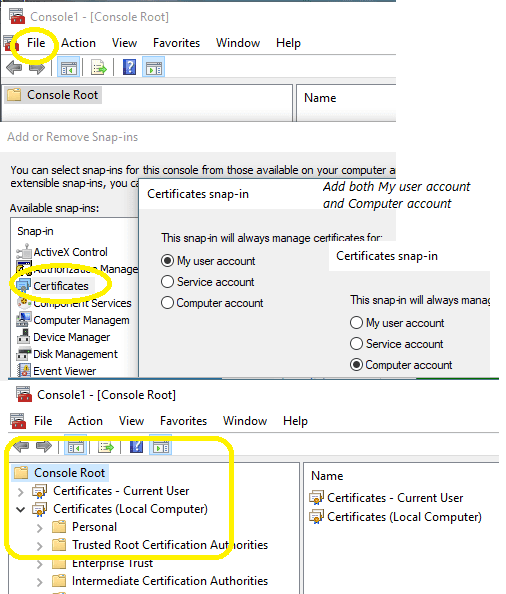
- In the
Add/Remove Snap-in window, click the
Add button.
- On the Snap-in list, select
Certificates and then click
Add.
- In the Certificates Snap-in window, select
My user account,
- and select
Certificates and then click
Add again.
- In the Certificates Snap-in window, select
Computer account, and then click
Next.
- In the Select Computer window, select
Local computer, and then click
Finish. This adds the Certificates Snap-in to the list. Close the window.
- In the Add/Remove snap-in window, click
OK. This adds the Certificates snap-in to the mmc console.
- Expand the Certificates node to see the different types of certificates.
Now you can view all certificates in current user store and local machine store.
As S/MIME Plug can’t access certificates from the
Current User Store, if your certificate is stored in the
Current User Store, you must export it from the
Current User Store.
Export Encryption Certificate from Certificate Store
You can export certificate from
Current User Store like this:
-
Certificates MMC Snap-in, select
Certificates - Current User ->
Personal ->
Certificates,
- If you want to export recipient’s certificate, select
Certificates - Current User ->
Other People ->
Certificates,
- Select the certificate(s) you want to export, you can select multiple certificates by
Ctrl +
Left Click,
- Right click ->
All Tasks ->
Export ->
Next
- Because encrypting email doesn’t not require private key, so please select
No, do not export the private key,
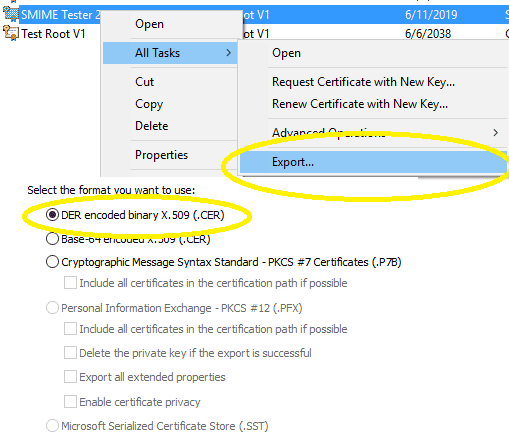
- If single certificate is selected, select
DER encoded binary X.509 (.CER),
- If multiple certificates are selected, select
Microsoft Serialized Certificate Store (.SST) or
Personal Information Exchange - PKCS #12 (.PFX) ->
Next,
- If pfx file type is selected, check
Password, and input a password as protection password,
- Save it as specified file.
You can use the exported certificate file as
Certificate Source in S/MIME Plugin.
Note
The certificate without a private key is used for email encryption only.
Pfx, Cert and Sst file
- Pfx file can contain multiple certificates with public/private keys, it can be used for both email signing and encryption.
- Cert file is a single certificate without a private key, it is used for email encryption only.
- Sst file contains multiple certificates without a private key, it is used for email encryption only.
Import Certificate to Certificate Store
You can import a certificate file to
Certificate Machine Store like this:
-
Certificates MMC Snap-in, select
Certificates - (Local Computer) ->
Personal ->
Certificates,
- Right click ->
All Tasks ->
Import,
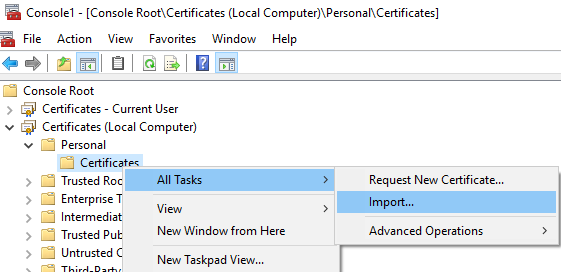
- Select certificate type and input certificate path ->
Next,
- If it is pfx file, you should input pfx protection password and check
Mark this key as exportable ...,
- Place all certificates in the following store:
Personal ->
Next ->
Finish.
After certificate file was imported to
Certificate Machine Store, you can use
Certificate Machine Store as
Certificate Source instead of certificate file.
Generate Self-Signed Root Certificate
If the email digital certificate is not issued by third-party authorities, the email client will prompt an error of “Certificate
is not issued by a trusted publisher”.
However, for internal enterprise usage or test purpose, you can create a self-signed root certificate and issue this digital
certificate to internal users by
New-SelfSignedCertificate PowerShell cmdlet.
Note
If you have an existing certificate from third-party authorities, you can skip this section.
Note
New-SelfSignedCertificate requires PowerShell 3.0 on Windows 10, Windows 8/8.1 and Windows Server 2012/2012 R2/2016.
You can create a root certificate like this:
New-SelfSignedCertificate -Type Custom -HashAlgorithm sha256 -KeyLength 2048 -KeyUsage CRLSign, CertSign, KeyAgreement, DataEncipherment, KeyEncipherment, DigitalSignature -KeyAlgorithm RSA -Subject "CN=Test Root V1" -CertStoreLocation "cert:\CurrentUser\My" -NotAfter (get-date).AddDays(7300)
Then the new root certificate can be found in
Certificates MMC Snap-in, select
Certificates - Current User ->
Personal ->
Certificates.
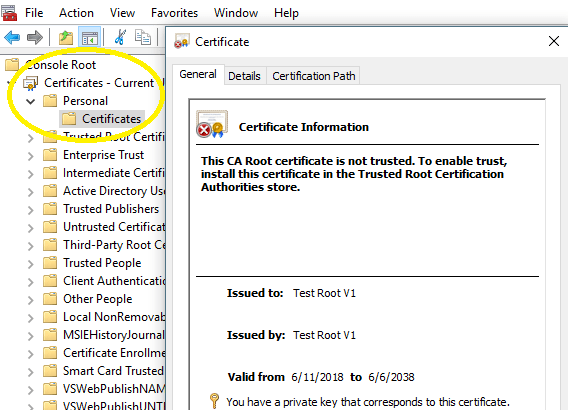
Now you can issue the certificate to users from root certificate like this:
Generate Email Certificate Issued by Root Certificate
Here is an example to issue the certificate from the root certificate generated in the previous section.
Set-Location -path cert:\CurrentUser\My
$signer = Get-Childitem -DnsName "Test Root V1"
New-SelfSignedCertificate -HashAlgorithm sha256 -Type Custom -Subject "E=test@emailarchitect.net,CN=SMIME Tester 2048" -TextExtension @("2.5.29.37={text}1.3.6.1.5.5.7.3.4","2.5.29.17={text}email=test@emailarchitect.net&upn=test@emailarchitect.net") -KeyLength 2048 -KeyAlgorithm RSA -SmimeCapabilities -CertStoreLocation "Cert:\CurrentUser\My" -NotAfter (get-date).AddDays(365) -Signer $signer
Then the new email certificate can be found in
Certificates MMC Snap-in, select
Certificates - Current User ->
Personal ->
Certificates.
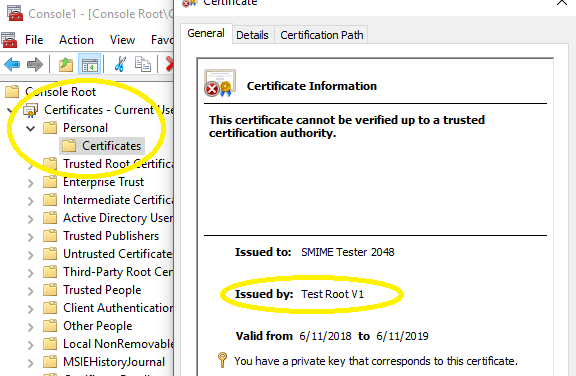
You can export it together with a private key as a pfx file and use it in
Certificate Source. Alternatively, you can install a pfx file to
Certificates (Local Computer) ->
Personal ->
Certificates and use
Machine Store as
Certificate Source.
Install Root Certificate to Client Machine
If you used the above certificate to sign emails, email client would give an error about
Certificate is not issued by a trusted publisher. You can install the root certificate to client machines like this to avoid the error.
Now you can export the root certificate to a cert file and install it on
Trusted Root Certification Authorities:
-
Certificates MMC Snap-in, select
Certificates - Current User ->
Personal ->
Certificates,
- Select the root certificate (Test Root V1),
- Right click ->
All Tasks ->
Export ->
Next
- Select
No, do not export the private key,

- Select
DER encoded binary X.509 (.CER),
- Save it as .cer file.
Install it to
Local\Computer\Trusted Root Certification Authorities
-
Certificates MMC Snap-in, select
Certificates - (Local Computer) ->
Trusted Root Certification Authorities ->
Certificates,
- Right click ->
All Tasks ->
Import,
- Select the .cer file from local disk ->
Next,
- Place all certificates in the following store:
Trusted Root Certification Authorities ->
Next ->
Finish.
Install it to
Current User\Trusted Root Certification Authorities
-
Certificates MMC Snap-in, select
Certificates - Current User ->
Trusted Root Certification Authorities ->
Certificates,
- Right click ->
All Tasks ->
Import,
- Select the .cer file from local disk ->
Next,
- Place all certificates in the following store:
Trusted Root Certification Authorities ->
Next ->
Finish.
After you installed the root certificate to
Trusted Root Certification Authorities, user certificate chain becomes valid now.
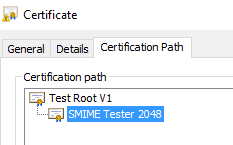
Create a Rule for Email Encryption
Let’s create a test email encryption rule for a recipient like this:
- Click
Email Encryption ->
New,
- Input any description for current rule,
- Input a recipient email address in
Recipient Address,
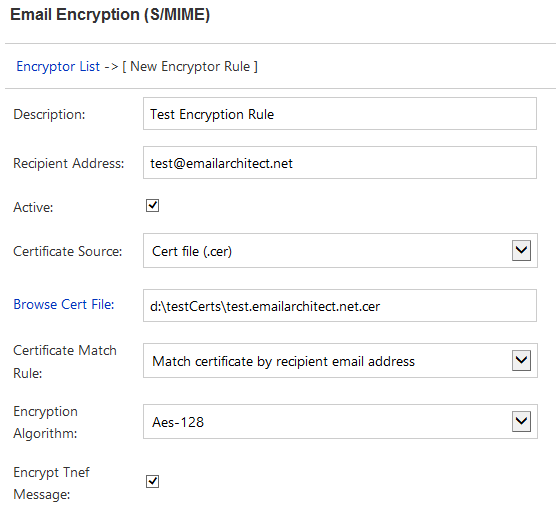
- Change
Certificate Source to
Cert file (.cer),
- Input
Cert file path,
Important
IIS SMTP Service is running as
Local System user, and Exchange Transport Agent is running as
Network Service user, so do not put the certificate file to
Desktop or user-dependent folder, S/MIME Plugin doesn’t have permission to read certificate files in these locations.
- Finally, click
Save to save current rule.
After rule is saved, click
Test, current rule will be executed with a virtual email message, you can find the result in test dialog box.
If
Test all rules is checked, all rules defined on current machine will be executed with a virtual email message.
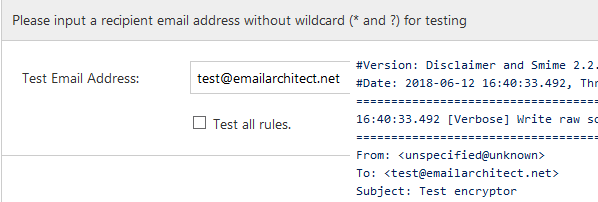
If the test result looks good, you can send a test email to that recipient, and validate if the received email was encrypted.
Recipient Address Pattern and Wildcard
A single email address or email address with wildcard (* and ?) can be used in
Recipient Address. It indicates current rule is only enabled for matched recipient address.
An encryption certificate can be only used for a specific email address. For example, you cannot use
test@emailarchitect.net's certificate to encrypt email to
support@emailarchitect.net, email client would prompt an error due to address not match.
Therefore, if you used wildcard (* and ?) in recipient address, you should specify a
Certificate Source that contains multiple certificates, and set
Certificate Match Rule to
Match certificate by recipient email address, to enable S/MIME Plugin to find the correct certificate to encrypt the email.
Note
If no certificate is identified for all recipients, the message won’t be encrypted.
Certificate Source and Certificate Match Rule
Certificate Source
-
- Certificate Machine Store
-
Look up the certificate from Windows built-in certificate machine store.
-
- Pfx File
-
Look up the certificate from specified P12/Pfx (.pfx, .p12) file.
-
- Sst File
-
Look up the certificate from specified Sst (.sst) file.
-
- Cert File
-
Look up the certificate from specified Cert (.cer) file.
Machine store, pfx file and sst file can contain multiple certificates, while cert file can only contain one certificate.
Please refer to
Import, Export and Generate Test Certificate to learn how to import/export certificate from certificate store.
Certificate Match Rule
-
- Match certificate by recipient email address
-
This option is recommended. The digital certificate can be found based on recipient email address, it can be used
with any certificate source.
-
- Specified certificate
-
To use this option,
Recipient Address should not contain wildcard (* and ?). You can use it when the certificate subject doesn’t contain an email address.
Email Encryption Algorithm
Rc2, TripleDes, Aes-128, Aes-192 and Aes-256 are supported. For security reason, Aes-128, Aes-192 or Aes-256 is recommended.
AES with RSA-OAEP Hash Encryption Padding Algorithm
To comply with EDIFACT in Germany/EUROPE, please select sha256 or higher SHA algorithm in OAEP hash algorithm option and use AES-128/192/256 encryption algorithm.
Encrypt Tnef Message
Tnef is an internal email format in Exchange Server. If this option is checked, Tnef messages will first be converted to
RFC822/message format by S/MIME Plugin, and then be encrypted by the specified certificate.
See Also
Email Disclaimer
Digital Signature
Journal and Troubleshooting
Appendix - Set up DomainKeys/DKIM
Appendix - Set up SPF record in DNS server
Online Tutorials:
Add Disclaimer or Signature with Embedded Images in Exchange Server 2007/2010/2013/2016/2019 - Tutorial
Add Digital Signature (S/MIME) to Email in Exchange Server 2007/2010/2013/2016/2019 - Tutorial
Encrypt Email (S/MIME) in Exchange Server 2007/2010/2013/2016/2019 - Tutorial
Add Disclaimer or Signature with Embedded Images in IIS SMTP Service and Exchange Server 2003 - Tutorial
Add Digital Signature (S/MIME) to Email in IIS SMTP Service and Exchange Server 2003 - Tutorial
Encrypt Email (S/MIME) in IIS SMTP Service and Exchange Server 2003 - Tutorial










